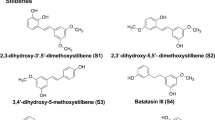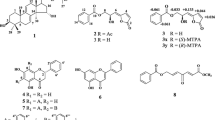Abstract
Cancer is a leading cause of death worldwide. In our continuing search for new anticancer agents, four Malaysian Calophyllum species, namely C. castaneum, C. teysmannii, C. canum, and C. sclerophyllum, had been phytochemically studied to give compounds 1–12. All the isolated compounds were evaluated for their antiproliferative activity against nasopharyngeal (SUNE1, TW01, CNE1, HK1) and breast (HCC38, MDA-MB-231, MDA-MB-468, SKBR3) cancer cell lines via methyl thiazolyl tetrazolium cell viability assay. Among the tested compounds, isodispar B (1) showed a promising dose-dependent and a broad spectrum of cytotoxic effects on all the tested cancer cell lines; in particular, potent inhibitory activities were observed on nasopharyngeal cancer cell lines (SUNE1, TW01, CNE1, HK1), with IC50 values ranging from 3.8 to 11.5 µM. In comparison with 5-fluorouracil as positive control, compound 1 was found to exhibit at least sixfold much higher activity than the standard drug used against the nasopharyngeal cell lines. Compound 1 was later found to induce apoptotic cell death in nasopharyngeal cancer cells, as evidenced by ‘Cell Death Detection’ ELISAPLUS kit, and exhibited good cancer-specific cytotoxicity when tested with noncancerous NP460 cells. Meanwhile, compounds 2–12 displayed moderate to weak activities against the tested cancer cell lines. The findings have highlighted the therapeutic potential of compound 1 against nasopharyngeal cancer.



Similar content being viewed by others
References
Bayma JC, Arruda MSP, Neto MS (1998) A prenylatedxanthone from the bark of Symphonia globulifera. Phytochemistry 49:1159–1160
Bedoya LM, Beltrán M, Sancho R, Olmedo DA, Sánchez-Palomino S, Olmo E, López-Pérez JL, Muñoz E, Feliciano AS, Alcamí J (2005) 4-Phenylcoumarins as HIV transcription inhibitors. Bioorg Med Chem Lett 15:4447–4450
Brahmachari G, Jash SK (2014) Naturally occurring calanolides: an update on their anti-HIV potential and total syntheses. Recent Pat Biotechnol 8:3–16
Cragg GM, Newman DJ (2003) Plants as a source of anti-cancer and anti-HIV agents. Ann Appl Biol 143:127–133
Csupor-Löffler B, Hajdú Z, Zupkó I, Molnár J, Forgo P, Vasas A, Kele Z, Hohmann J (2011) Antiproliferative constituents of the roots of Conyza canadiensis. Planta Med 77:1183–1188
Cuesta-Rubio O, Oubada A, Bello A, Maes L, Cos P, Monzote L (2015) Antimicrobial assessment of resins from Calophyllum Antillanum and Calophyllum Inophyllum. Phytother Res 29:1991–1994
Dharmaratne HRW, Napagoda MT, Tennakoon SB (2009) Xanthones from roots of Calophyllum thwaitesii and their bioactivity. Nat Prod Res A: Struct Synth 23:539–545
Elmore S (2007) Apoptosis: a review of programmed cell death. Toxicol Pathol 35:495–516
GLOBOCAN (2012) Cancer incidence and mortality worldwide: IARC CancerBase No. 11. http://globocan.iarc.fr. Accessed 16 July 2015
Guilet D, Séraphin D, Rondeau D, Richomme P, Bruneton J (2001) Cytotoxic coumarins from Calophyllum dispar. Phytochemistry 58:571–575
Hay AE, Hélesbeux JJ, Duval O, Labaïed M, Grellier P, Richomme P (2004) Antimalarial xanthones from Calophyllum caledonicum and Garcinia vieillardii. Life Sci 75:3077–3085
Ito C, Itoigawa M, Furukawa H, Tokuda H, Okuda Y, Mukainaka T, Okuda M, Nishino H (1999) Anti-tumor-promoting effects of 8-substituted 7-methoxycoumarins on Epstein-Barr virus activation assay. Cancer Lett 138:87–92
Jain SC, Singh B, Jain R (2001) Antimicrobial activity of triterpenoids from Heliotropium ellipticum. Fitoterapia 72:666–668
Kouam SF, Yapna DB, Krohn K, Ngadjui BT, Ngoupayo J, Choudhary MI, Schulz B (2007) Antimicrobial prenylatedanthracene derivatives from the leaves of Harungana madagascariensis. J Nat Prod 70:600–603
Lim CK, Subramaniam H, Say YH, Jong VY, Khaledi H, Chee CF (2015) A new chromanone acid from the stem bark of Calophyllum teysmannii. Nat Prod Res 29:1970–1977
Lim CK, Tho LY, Lim CH, Lim YM, Shah SAA, Weber JFF (2011) Synthesis and SAR study of prenylatedxanthone analogues as HeLa and MDA-MB-231 cancer cell inhibitors. Lett Drug Des Disc 8:523–528
Lin CM, Huang ST, Lee FW, Kuo HS, Lin MH (2006) 6-Acyl-4-aryl/alkyl-5,7-dihydroxycoumarins as anti-inflammatory agents. Bioorg Med Chem 14:4402–4409
López-Pérez JL, Olmedo DA, Olmo E, Vásquez Y, Solís PN, Gupta MP, Feliciano AS (2005) Cytotoxic 4-phenylcoumarins from the leaves of Marila pluricostata. J Nat Prod 68:369–373
Low SY, Tan BS, Choo HL, Tiong KH, Khoo AS, Leong CO (2012) Suppression of BCL-2 synergizes cisplatin sensitivity in nasopharyngeal carcinoma cells. Cancer Lett 314:166–175
Mah SH, Ee GCL, Teh SS, Sukari MA (2015) Calophyllum inophyllum and Calophyllum soulattri source of anti-proliferative xanthones and their structure–activity relationships. Nat Prod Res 29:98–101
Mai CW, Pakirisamy P, Tay EF, Subramaniam S, Shamsuddin ZH, Pichika MR (2009) Nasopharyngeal carcinoma cell proliferation and apoptosis induced by the standardised ethanolic extracts of Mucuna bracteata. Malays J Chem 11:143–148
Mai CW, Yaeghoobi M, Abd-Rahman N, Kang YB, Pichika MR (2014) Chalcones with electron-withdrawing and electron-donating substituents: anticancer activity against TRAIL resistant cancer cells, structure-activity relationship analysis and regulation of apoptotic proteins. Eur J Med Chem 77C:378–387
Morel C, Séraphin D, Teyrouz A, Larcher G, Bouchara JP, Litaudon M, Richomme P, Bruneton J (2002) New and antifungal xanthones from Calophyllum caledonicum. Planta Med 68:41–44
Oliveira MC, Lemos LMS, de Oliveira RG, Dall’Oglio EL, de Sousa Júnior PT, de Oliveira Martins DT (2014) Evaluation of toxicity of Calophyllum brasiliense stem bark extract by in vivo and in vitro assays. J Ethnopharmacol 155:30–38
Pedro M, Cerqueira F, Sousa ME, Nascimentoa MSJ, Pinto M (2002) Xanthones as inhibitors of growth of human cancer cell lines and their effects on the proliferation of human lymphocytes in vitro. Bioorg Med Chem 10:3725–3730
Plattner RD, Spencer GF, Weisleder D, Kleiman R (1974) Chromanone acids in Calophyllum brasiliense seed oil. Phytochemistry 13:2597–2602
Reutrakul V, Chanakul W, Pohmakotr M, Jaipetch T, Yoosook C, Kasisit J, Napaswat C, Santisuk T, Prabpai S, Kongsaeree P, Tuchinda P (2006) Anti-HIV-1 constituents from leaves and twigs of Cratoxylum arborescens. Planta Med 72:1433–1435
Sandjo LP, Foster AJ, Rheinheimer J, Anke H, Opatz T, Thines E (2012) Coumarin derivatives from Pedilanthus tithymaloides as inhibitors of conidial germination in Magnaporthe oryzae. Tetrahedron Lett 53:2153–2156
Saraste A, Pulkki K (2000) Morphologic and biochemical hallmarks of apoptosis. Cardiovasc Res 45:528–537
Shen T, Zhang L, Wang YY, Fan PH, Wang XN, Lin ZM, Lou HX (2012) Steroids from Commiphora mukul display antiproliferative effect against human prostate cancer PC3 cells via induction of apoptosis. Bioorg Med Chem Lett 22:4801–4806
Sousa GF, Duarte LP, Alcantara AFC, Silva GDF, Vieira-Filho SA, Silva RR, Oliveira DM, Takahashi JA (2012) New triterpenes from Maytenus robusta: structural elucidation based on NMR experimental data and theoretical calculations. Molecules 17:13439–13456
Taher M, Attoumani N, Susanti D, Ichwan SJA, Ahmad F (2010) Antioxidant activity of leaves of Calophyllum rubiginosum. Am J Appl Sci 7:1305–1309
Tan BS, Kang O, Mai CW, Tiong KH, Khoo AS, Pichika MR, Bradshaw TD, Leong CO (2013) 6-Shogaol inhibits breast and colon cancer cell proliferation through activation of peroxisomal proliferator activated receptor gamma (PPARgamma). Cancer Lett 336:127–139
Viswanathan MB, Ananthi JDJ, Kumar PS (2012) Antimicrobial activity of bioactive compounds and leaf extracts in Jatropha tanjorensis. Fitoterapia 83:1153–1159
Wu YP, Zhao W, Xia ZY, Kong GH, Lu XP, Hu QF, Gao XM (2013) Three new xanthones from the stems of Garcinia oligantha and their anti-TMV activity. Phytochem Lett 6:629–632
Ziegler U, Groscurth P (2004) Morphological features of cell death. News Physiol Sci 19:124–128
Acknowledgments
This work was financially supported by the UTAR Research Fund (Project No. IPSR/RMC/UTARRF/2013-C2/L09). The authors would also like to thank Mr. Tinjan Anak Kuda for authentication of the plant material, and the Cancer and Stem Cell Research Centre of International Medical University (IMU) for technical supports.
Author information
Authors and Affiliations
Corresponding author
Ethics declarations
Conflict of interest
The authors declare that they have no conflict of interests.
Rights and permissions
About this article
Cite this article
Lim, C.K., Hemaroopini, S., Gan, S.Y. et al. In vitro cytotoxic activity of isolated compounds from Malaysian Calophyllum species. Med Chem Res 25, 1686–1694 (2016). https://doi.org/10.1007/s00044-016-1606-y
Received:
Accepted:
Published:
Issue Date:
DOI: https://doi.org/10.1007/s00044-016-1606-y




